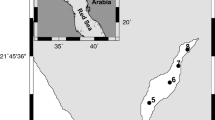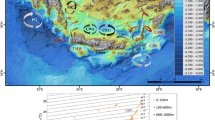Abstract
Sharm Obhur is a narrow coastal inlet about 10 km long. The maximum depth at the entrance is about 35 m, which decreases gradually towards the head. Nine field trips were conducted for hydrographic survey in the Sharm during April 2015–January 2016 covering pre-summer transition, summer, pre-winter transition and winter seasons. In each trip, eight stations along the central axis of the Sharm were occupied for the measurement of temperature and salinity. In addition, an Acoustic Doppler Current Profiler (ADCP) mooring was deployed near the entrance (at station 2) during 18 February–26April 2015. The vertical structures of temperature and salinity show two distinct layers—a relatively low saline surface layer and a high saline bottom layer. The thermohaline properties increase from the entrance towards the head in all the seasons except for a slight decrease in temperature during December. Near the head, the observed maximum temperature and salinity are 33.22 °C (August) and 40.36 psu (April), respectively, while the observed minimum temperature and salinity are 25.05 °C and 38.97 psu, respectively, during January. The water exchange between the Sharm and the Red Sea shows two-layer structure, with a surface inflow and a deep outflow which is typical of basins where evaporation exceeds precipitation. The pressure gradient generated by the increasing density towards the head pushes the relatively low saline surface water from the Red Sea to the Sharm with a gradient in surface salinity influenced by the evapouration and heat exchange. Near the head, it sinks and returns as a deep water flow. The estimated flushing time of the Sharm varies between 7 and 12 days with an average of 9.5 days.









Similar content being viewed by others
References
Ady J, Aktar O, Joma A, Mattar M, Nakshbandi A, Al Qahtani S, Al Regaily Z, Samarkandi R (1995) The Farasan Islands: nature reserves and recreation areas: masterplan with guidelines. Unpublished report to NCWCD No. 3-1995-105. King Abdulaziz University, Jeddah, and NCWCD, Riyadh, pp 81
Ahmad F, Sultan SAR (1993) Tidal and sea level changes at Jeddah, Red Sea. Pakistan Joumal Mar Sci 2:77–84
Albarakati AMA (2009) Water exchange of Sharm Obhur, Jeddah, Red Sea. JKAU Mar Sci 20:49–58. doi:10.4197/Mar.20-1.4
Albarakati AMA (2010) Some hydrographic features of Rabigh Lagoon along the eastern coast of the Red Sea. J King Abdulaziz Univ Mar Sci 21:123–132. doi:10.4197/Mar.21-1.7
Albarakati AMA (2012) The flushing time of an environmentally sensitive, Yanbu Lagoon along the Eastern Red Sea Coast. Int J Eng Technol 2:135–140
Alsaafani MA (2013) Coastal currents and water characteristics along Algahaz Coast, Jeddah during Summer 2012. JKAU Mar Sci 24:99–112. doi:10.4197/Mar.24-2.7
Alshaikh A (2013) A combined use of remote sensing and GIS to detect environmental degradation in the Jeddah coastal zone, Saudi Arabia. Life Sci J 10:472–478
Al-Subhi AM (2011) A study of vertical mixing processes in Sharm Obhur, Eastern Red Sea During Summer. JKAU Mar Sci 22:97–111
Basaham AS, El-Shater A (1994) Textural and mineralogical characteristics of the surficial sediments of Sharm Obhur, Red Sea Coast of Saudi Arabia. JKAU Mar Sci 5:51–71. doi:10.4197/mar.5-1.5
Basaham A, Rifat A, El-Sayed M, Rasool N (2006) Sharm Obhur: environmental consequences of 20 years of uncontrolled coastal urbanization. JKAU Mar Sci 17:129–152. doi:10.4197/mar.17-1.8
Behairy AK, El-Rayis O, Ibrahim A (1983) Preliminary investigation of some heavy metals in water, sediments and plankton in Obhur Creek (Eastern Red Sea). JKAU Mar Sci 3:129–140
Brooks DA (1978) Subtidal sea level fluctuations and their relation to atmospheric forcing along the North Carolina Coast. J Phys Oceanogr 8:481–493
El-Rayis OA, Eid FM (1997) Hydrography and water budget of Obhur Creek, Red Sea. JKAU Mar Sci 8:29–45
Fischer HB, List JE, Koh CR et al (1979) Mixing in inland and coastal waters. Academic Press, New York
Godin G (1972) The analysis of tides. University of Toronto Press, Toronto
Rasul NMA (2015) Lagoon sediments of the Eastern Red Sea: distribution processes, pathways and patterns. In: Rasul N, Stewart I (eds) The Red Sea. Springer, Berlin Heidelberg, pp 281–316
Smith NP (1977) Meteorological and tidal exchanges between Corpus Christi Bay, Texas, and the northwestern Gulf of Mexico. Estuar Coast Mar Sci 5:511–520. doi:10.1016/0302-3524(77)90098-6
Smith NP (1978) Long-period, estuarine-shelf exchanges in response to meteorological forcing. Elsevier Oceanogr Ser 23:147–159. doi:10.1016/S0422-9894(08)71276-5
Sverdrup HU, Johnson MW, Fleming RH (1942) The oceans: their physics, chemistry, and general biology: Harald Ulrik Sverdrup, Martin W. Johnson, Richard H. Fleming: Amazon.com: Books. Prentice Hall Inc.
Timothy DJ (1998) Cooperative tourism planning in a developing destination. J Sustain Tour 6:52–68. doi:10.1080/09669589808667301
Wafar M, Ashraf M, Manikandan KP et al (2015) Propagation of Gulf of Aden Intermediate Water (GAIW) in the Red Sea during autumn and its importance to biological production. J Mar Syst 154:243–251. doi:10.1016/j.jmarsys.2015.10.016
Zimmerman JTF (1981) The flushing of well-mixed tidal lagoons and its seasonal fluctuations. Coastal lagoon research. Present and future. In: Proceedings of UNESCO/IABO Seminar. UNESCO technical papers in marine science. p 33.
Acknowledgements
The authors appreciate the time and efforts of Mr. Abdulla C.P., Mr. Shanas P.R., Mr. S. Garbi, Mr. A. Taqi, Mr. Kamalaldien M., and Mr. A. Alamshani in data collection and Professor F. Ahmad and V M Aboobacker for their valuable comments in reviewing the manuscript. This project was funded by the Deanship of Scientific Research (DSR), King Abdulaziz University, under grant no. (114-150-1436). The authors, therefore, acknowledge with thanks the DSR’s technical and financial support.
Author information
Authors and Affiliations
Corresponding author
Rights and permissions
About this article
Cite this article
Alsaafani, M.A., Alraddadi, T.M. & Albarakati, A.M. Seasonal variability of hydrographic structure in Sharm Obhur and water exchange with the Red Sea. Arab J Geosci 10, 315 (2017). https://doi.org/10.1007/s12517-017-3108-8
Received:
Accepted:
Published:
DOI: https://doi.org/10.1007/s12517-017-3108-8




